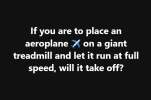The "airplane on a treadmill" argument has resurface on Facebook. 

 www.facebook.com
www.facebook.com


Neil deGrasse Tyson | If you are to place an aeroplane ✈ on a giant treadmill and let it run at full speed, will it take off | Facebook
If you are to place an aeroplane ✈ on a giant treadmill and let it run at full speed, will it take off?
 www.facebook.com
www.facebook.com





